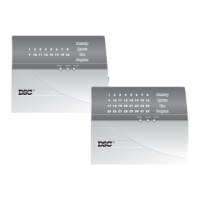16
Contrast Control
The LCD keypad will allow you to select from 10 different display contrast levels. Use the
arrow keys (< >) to scroll to the desired contrast level and press the [#] key to exit.
Viewing the Event Buffer from an LCD Keypad
The event buffer records the last 128 events that have occurred. Select “View Event Buffer”
from the [][6] menu. The keypad will display the event, event number, time and date along
with the zone number and user code, if applicable. Press [] to toggle between this
information and the event itself. Use the arrow keys (<>) to scroll through the events in the
buffer. When you have finished viewing the Event Buffer, press the [#] key to exit.
Fire Alarm Operation
Alarm
On a fire alarm, the bell or siren will pulse ON and OFF. The transmission of the alarm to the
monitoring station is delayed for 30 seconds. If the alarm is not cleared within the 30 second
delay, then it will be transmitted to the monitoring station.
Silence
To silence the bell or siren, press the [#] key. If the alarm is silenced and the smoke detector
is not reset, the alarm will resound after 90 seconds.
Resetting Smoke Detectors
Once the smoke detector is reset, if it still detects smoke, the alarm sequence will resound
as described above. If there is no smoke, the system will return to normal.
To reset smoke detectors from an LED Keypad:
Press [][7][2].
To reset smoke detectors from an LCD Keypad:
Press [] to enter the function list. Scroll to find:
Press [] to select the output control. The display will read...
Use the arrow (< >) keys to find the following message and press
the [] key to select...
NOTE: If you suspect that a fire alarm has transmitted and that there is no fire
condition, call the monitoring station to avoid an unnecessary response. If a fire
condition is apparent, follow your evacuation plan immediately. If the alarm sounds at
night, evacuate immediately.
NOTE: The description above may not be applicable depending on how your installer
has programmed the fire alarm operations on your system. Ask your installer for more
information regarding your system's operation.
Guidelines for Locating Smoke Detectors
Research has shown that all hostile fires in homes generate smoke to a greater or lesser
extent. Experiments with typical fires in homes indicate that detectable quantities of smoke
precede detectable levels of heat in most cases. For these reasons, smoke alarms should
be installed outside of each sleeping area and on each storey of the home.
The following information is for general guidance only and it is recommended that local fire
codes and regulations be consulted when locating and installing smoke alarms.
It is recommended that additional smoke alarms beyond those required for minimum
protection be installed. Additional areas that should be protected include: the basement;
bedrooms, especially where smokers sleep; dining rooms; furnace and utility rooms; and
any hallways not protected by the required units.
On smooth ceilings, detectors may be spaced 9.1m (30 feet) apart as a guide. Other
spacing may be required depending on ceiling height, air movement, the presence of joists,
uninsulated ceilings, etc. Consult National Fire Alarm Code NFPA 72, CAN/ULC-S553-M86
Press (*) For <>
Output Control
Command O/P 1 <>
Command O/P 2 <>

